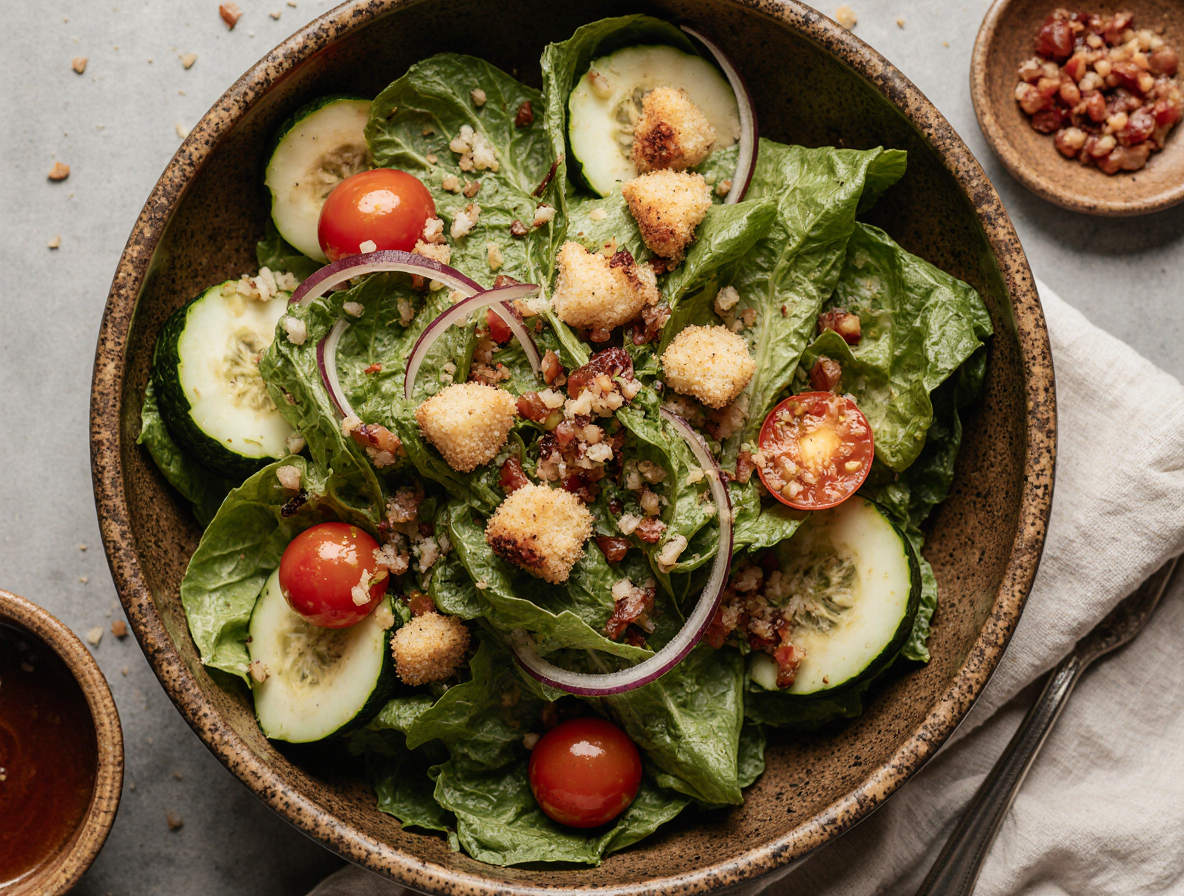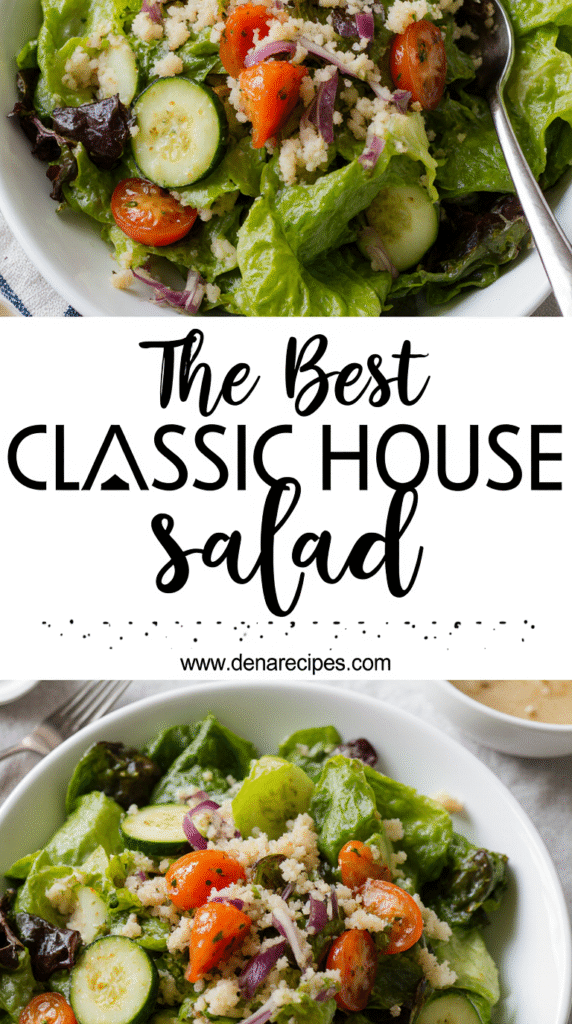How to Make the Perfect House Salad: A Restaurant Chef’s Guide
Did you know a classic house salad packs 314 calories with 21g of carbohydrates, 8g of protein, and 22g of fat per serving? Despite being a side dish, a well-crafted house salad should never play second fiddle to your main course.
The beauty of a house salad recipe lies in its simplicity. With just a handful of carefully selected ingredients, this versatile side pairs perfectly with pasta, pizza, or even meatloaf. However, creating a truly memorable classic house salad requires hitting all the flavor notes – sweet, salty, tangy, and bitter. In fact, because there aren’t many ingredients involved, learning how to make a house salad that stands out really depends on using quality components and an exceptional dressing.
In this guide, I’ll walk you through everything you need to know about crafting restaurant-quality house salads at home. From selecting the freshest ingredients to balancing flavors perfectly, you’ll soon be serving salads that your family requests by name.
What is a House Salad?
A house salad stands as the foundation of American restaurant dining, representing the most straightforward salad offering on virtually any menu. The name might seem contradictory since we rarely call it a “house salad” at home, yet it’s the standard salad served across mainstream American restaurants from Cheddar’s and Chili’s to Outback and Applebees.
What exactly constitutes a house salad? Essentially, it’s a basic green salad with vegetables that serves as an ideal starter or accompaniment to main dishes. Traditionally, house salads feature romaine lettuce, tomatoes, cucumbers, cheddar cheese, and croutons. Many establishments add their own signature touches while maintaining the classic framework.
The term “house salad” appears on menus nationwide, typically referring to the regular salad option at a restaurant. When a server asks, “Would you like the house salad or a spinach salad?” they’re distinguishing between the standard offering and specialty alternatives.
Throughout history, the evolution of salads in American dining culture has been noteworthy. During the 20th century, the mixed salad became a restaurant staple, often including tomatoes, peppers, lettuce, celery, sometimes spinach, and usually chives. By mid-century, the tossed salad—frequently drowning under thick dressing—became the standard starter preceding a traditional meat and potatoes dinner.
The beauty of a house salad lies in its versatility. While maintaining a consistent base of leafy greens, restaurants often customize with:
- Vegetables: Cherry tomatoes, shredded carrots, bell peppers, red onions, cucumbers
- Toppings: Croutons, bacon bits, cheese (often cheddar or feta), sunflower seeds
- Optional additions: Olives, chickpeas, hard-boiled eggs, or seasonal ingredients
A well-crafted house salad achieves balance by incorporating sweet, salty, tangy, and bitter elements. The vegetables provide crisp texture and freshness, while toppings add depth and complexity.
What truly distinguishes one house salad from another is often the dressing. Although ranch remains exceedingly popular, vinaigrettes, blue cheese, Thousand Island, and Italian dressings are equally common choices. Many restaurants additionally offer a signature “house dressing” that sets their salad apart.
The appeal of a house salad primarily stems from its refreshing qualities. The crisp vegetables offer fiber and nutrients, making it the perfect starter that leaves plenty of room for heartier fare. It’s particularly effective at balancing richer main courses like burgers, steaks, or pasta dishes.
Essential Ingredients for a Classic House Salad
Creating the perfect house salad starts with selecting the right combination of fresh ingredients. The foundation of any classic house salad lies in its carefully chosen components that deliver a balance of flavors, textures, and nutrients.
Choosing the right greens
Crisp, fresh greens form the backbone of any house salad. Romaine lettuce remains the most popular choice due to its crunch and mild flavor. Furthermore, mixing different varieties creates more interesting textures—try combining romaine with butter lettuce or green leaf lettuce. For added nutritional punch, iceberg lettuce provides crispness, whereas spinach or kale delivers more vitamins and minerals. Remember that red and dark green leafy vegetables generally contain higher nutrients than lighter-colored varieties.
Best vegetables to include
Beyond greens, the classic house salad typically features:
- Tomatoes: Cherry or grape tomatoes work best as they’re less watery and maintain better flavor year-round
- Cucumbers: English cucumbers offer tender skin that doesn’t require peeling
- Red onions: Thinly sliced for a milder bite than yellow or white varieties
- Shredded carrots: Add color, crunch, and sweetness
- Radishes: Provide a peppery crunch that balances other flavors
Optional toppings for extra flavor
Elevate your house salad with these additions:
- Croutons: Garlic and butter varieties add delightful crunch
- Cheese: Freshly shredded from a block rather than pre-shredded for superior flavor
- Bacon bits: Offer savory, smoky notes
- Seeds and nuts: Sunflower seeds or toasted almonds provide texture
- Avocado: Contributes creamy richness
Tips for selecting fresh produce
When shopping for salad ingredients, look for:
- Lettuce with crisp, vibrant leaves without wilting or discoloration
- Tomatoes that are firm and brightly colored
- Cucumbers that feel firm with no soft spots
- Onions that are heavy for their size with dry, papery skin
- Wash all produce thoroughly under running water before preparation, even if you don’t plan to eat the skin
Properly selected ingredients make all the difference between an ordinary side dish and a standout house salad that complements any meal.
How to Make a House Salad at Home
Preparing a restaurant-quality house salad begins long before you toss the ingredients together. With proper technique, your homemade creation can rival any establishment’s signature offering.
Step-by-step preparation guide
Initially, thoroughly wash all produce under cold running water. For lettuce, separate the leaves first to remove hidden dirt. After washing, drying is crucial – use a salad spinner or pat gently with paper towels until completely dry. Moisture is the enemy of crisp salads!
Next, consider how you’ll break down your greens. Tear lettuce instead of cutting whenever possible. Tearing follows natural fault lines in the leaf, rupturing fewer cells and slowing browning. This simple technique can extend your salad’s freshness by one to two days.
Then, prepare your vegetables in bite-sized pieces. There’s nothing more frustrating than wrestling with enormous lettuce leaves at the table. For cucumbers and firmer vegetables, thin slices work best. Cherry tomatoes can be halved or quartered based on your preference.
Finally, place greens in a large bowl followed by prepared vegetables. If serving immediately, add the dressing and toss until evenly coated.
How to keep ingredients crisp
The paper towel method stands out as the most effective technique for maintaining freshness. Line your storage container with dry paper towels, add your greens, then top with another paper towel before sealing. This absorbs excess moisture that causes wilting.
Furthermore, store prepared ingredients separately until ready to serve. Place each component in individual containers in the refrigerator. For optimal results, keep tomatoes at room temperature until assembly time to preserve their flavor.
When to add croutons and cheese
Always add croutons just before serving to prevent sogginess. Once exposed to moisture, croutons quickly lose their delightful crunch – the textural contrast that makes house salads so satisfying.
Similarly, cheese should be added near the final stages of preparation. Shaved Parmesan works beautifully when sprinkled half in the mix and half on top, ensuring it doesn’t all fall to the bottom.
Most importantly, dress your salad immediately before serving. Even sturdy romaine will wilt if left dressed too long. For gatherings, consider placing dressing on the side, allowing guests to add their preferred amount.
Homemade Dressings and Flavor Boosters
The secret to elevating your house salad from ordinary to extraordinary lies in the dressing. Homemade dressings not only taste infinitely better than store-bought options but also take less than five minutes to prepare.
Simple vinaigrette recipe
A classic vinaigrette follows a simple formula: two parts oil to one part acid. For a basic house salad dressing, whisk together:
- 1/2 cup quality extra virgin olive oil
- 1/4 cup vinegar (balsamic, red wine, or white wine)
- 1 teaspoon Dijon mustard
- Salt and pepper to taste
Creamy dressing options
For a richer option, try a tahini-based dressing with 3 tablespoons tahini, 2 tablespoons lemon juice, 1 tablespoon olive oil, and a teaspoon of maple syrup. Alternatively, Greek yogurt makes an excellent creamy base that adds protein and probiotics.
How to balance flavors in a dressing
Great dressings require balancing five taste elements: salty, sweet, sour, bitter, and umami. Acidity from vinegar or citrus creates vibrancy, whereas sweetness from honey or maple syrup counteracts bitterness. Salt enhances flavors, consequently making the entire salad more vibrant.
Store-bought vs homemade dressings
Homemade dressings allow you to control ingredients, avoid preservatives, and save money. Moreover, they keep for 7-10 days in the refrigerator. Above all, the fresh flavors simply cannot be matched by bottled alternatives that are manufactured for extended shelf life.
Conclusion
The perfect house salad truly stands as a cornerstone of any memorable meal, not merely an afterthought. Throughout this guide, we’ve explored how a seemingly simple side dish can become extraordinary with the right ingredients and techniques. Remember, quality ingredients make all the difference – crisp romaine lettuce, fresh vegetables, and thoughtfully selected toppings create that restaurant-worthy experience right at your dining table.
Most importantly, the dressing ties everything together. Homemade options require just minutes to prepare yet deliver flavors that store-bought varieties simply cannot match. The balance of sweet, salty, tangy, and bitter elements transforms ordinary ingredients into something spectacular.
Fresh produce selection and proper preparation techniques additionally ensure your salad maintains that perfect crispness. Tearing greens rather than cutting them, adding delicate ingredients at the last moment, and properly storing components separately until serving time all contribute to salad perfection.
You now have everything needed to create exceptional house salads that will impress family and friends alike. The next time you serve a main course, pair it with your signature house salad – one that reflects your personal taste while honoring the classic elements that make this dish timeless. After all, a well-crafted house salad never plays second fiddle; it harmonizes with the entire meal, creating a dining experience worth remembering.
FAQs
Q1. What are the key ingredients for a classic house salad? A classic house salad typically includes romaine lettuce, tomatoes, cucumbers, cheddar cheese, and croutons. For added flavor and texture, you can include shredded carrots, bacon bits, and sunflower seeds.
Q2. How can I make my homemade salad taste like a restaurant-quality one? To achieve a restaurant-quality salad at home, use fresh, high-quality ingredients, create a balanced mix of flavors and textures, and make your own dressing. Pay attention to ingredient preparation, such as tearing lettuce instead of cutting it, and add delicate ingredients like croutons just before serving.
Q3. What’s the secret to creating a great salad dressing? The secret to a great salad dressing is balancing five taste elements: salty, sweet, sour, bitter, and umami. For a simple vinaigrette, use a ratio of two parts oil to one part acid (like vinegar or lemon juice), and add Dijon mustard for emulsification. Experiment with different ingredients to find your perfect blend.
Q4. How can I keep my salad ingredients fresh and crisp? To keep salad ingredients fresh and crisp, store them separately until ready to serve. Use the paper towel method for greens: line a container with dry paper towels, add the greens, and top with another paper towel before sealing. Keep tomatoes at room temperature and add dressing just before serving to prevent wilting.
Q5. What are the five essential components of a perfect salad? The five essential components of a perfect salad are greens (for the base), sweetness (from fruits or certain vegetables), creaminess (from cheese or avocado), crunchiness (from nuts, seeds, or croutons), and dressing (to tie all the flavors together). Balancing these elements creates a well-rounded and satisfying salad.


